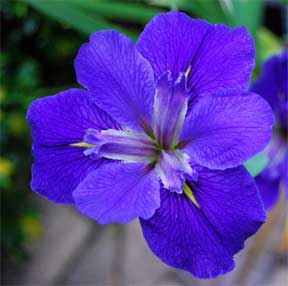Methods of growing this southern iris successfully in more rigorous climates, would differ from natural conditions found in its native habitat. Good drainage would he of supreme importance to insure hardiness of the rhizomes. The value of deep soil preparation for the planting cannot be overemphasized: this helps to provide better winter drainage and a greater reservoir for moisture during the growing period.
The removal of soil to a depth of 12 to 18 inches and refilling the space with a special soil mixture may seem an unnecessarily elaborate procedure. However, the strong luxuriant growth which will result from this special preparation, may mean success.

Many letters have been received from northern gardeners reporting that the rhizomes are hardy, yet they fail to bloom. It is my theory that the most essential phase of successful culture is being ignored—the paramount importance of the longest possible growing period following the flowering season. This produces strong foliage growth, which will result in good rhizome development in preparation for flowering the next season. This long growing period may be of special importance for successful flowering each year in gardens where winter growth is impossible.
It is quite true that, lacking moisture, Louisiana iris may go completely dormant after blooming and remain so for four or five months with no ill effect to the rhizomes. Indeed, this occurs during most summers in their native swamps as well as in many gardens. Yet, I have observed over the years that the marked profusion of bloom in the swamps is preceded by a wet summer.
In preparing soil which will induce the growth necessary for flowering these swamp beauties, peatmoss, in the coarsest grade, is the choicest ingredient that can be offered. This could make up one-third part of the planting medium, if you are willing to afford them the amount. Dairy fertilizer they love and one-third part would be greatly to their liking. Any moisture retentive material such as unscreened compost or rough woods soil is desirable as a substitute for dairy fertilizer and peatmoss. For added richness, a heavy dusting of cottonseed-meal and a well balanced commercial fertilizer may be used. To all this, add and thoroughly mix enough loam to form a mound. allowing for future settling and enough elevation to turn surplus winter moisture.
In northern gardens, spring planting is recommended. This will permit good establishment and desired foliage growth and rhizome development before the next winter.
As the iris show signs of growth, a program of regular light feedings of a well balanced commercial fertilizer and copious watering, when natural rainfall is lacking, may continue until the plants show a natural tendency to go dormant. Then, in late fall, cut the foliage near the ground and apply a mulch. This may be unnecessary but until more complete data on cold tolerance is available, mulching seems a wise procedure. Louisiana iris respond so readily to good culture that the flower size and height of bloom stern are mute evidence of the planting care and attention given during the growing season.
Each state, no doubt, has a favorite wild flower that reigns supreme in the affection of its people. We of Louisiana marvel at the serene beauty of our treasured Louisiana wild iris, in its picturesque setting and hope that gardeners all over the world will soon come to know and love them in their own gardens.
